| Pages:
1
..
7
8
9
10
11
..
18 |
Texium
Administrator
       
Posts: 4508
Registered: 11-1-2014
Location: Salt Lake City
Member Is Offline
Mood: PhD candidate!
|
|
Figured that this thread was worthy of being topped.
|
|
|
RogueRose
International Hazard
    
Posts: 1585
Registered: 16-6-2014
Member Is Offline
|
|
Making filters out of everyday materials
Was wondering if anyone has come up with some commonly available materials that can be used as filter material other than coffee filters. I have
noticed that some coffee filters that are shaped and stamped into a pocket form instead of the round "waffle" like shape, seem to have a more densely
packed fibre pattern. If a flat disc is needed, these could be cur from the filters.
I have used a number of different paper towels folded to make a funnel shape and either glued or stapled the sides closed. I found there are wide
range of paper towel types. Some of the cheap towels at gas stations that are almost like non-absorbent paper, work really well for fine filtration
once they become saturated. It also helps to use something like a strainer instead of a funnel as the contact of the paper on the funnel blocks the
flow, the open strainer allows for MUCH quicker flow through the paper & strainer.
I've found the local thrift store/charity shop/good will often has fabric remnants which can be a great source for cloth filters be they cotton, silk
or synthetic.
Cotton square swabs/pads. I've found the quilted squares about 45mm x 45mm work really well for fine filtration by laying out an over-laping layer
with each additional square offset about 25% width and continue until a line of them is ready to be rolled up. Once they are stacked, roll them VERY
tightly (for very fine filtration, maybe with a long thin nail or screw driver to wrap in the center) from one side of the layed out squares until the
diameter is reached. These rolls can be put inside pipe, plastic bottle mouths, prescription bottles, etc. If using something like a milk of soda
bottle, pushing the rolled cotton from the inside allows the bottle to funnel the roll into place.
The same thing as the above paragraph can be done with cuttings of cloth and rolled into a tight form.
Filter papers could be constructed from things like paper shopping bags (brown bags) which I would suspect have a much denser fiber ct than coffee
filters.
Artistic paper for drawing, painting, sketching, etc. Some of this stuff has cotton in it. There are various qualities of construction paper where
thickness and fiber size varies greatly. This could be a very good source for sub micron filtering.
I've used old T-shirts with the bottom tied very tight with fishing line. It is best to wrap many times and then fold back up and tie again as
wrapping around a single place can lead to slippage and the dumping of the filtered material all at once.
Socks work as well and are a good shape for filtering.
Anyone have any other ideas for things that can be used to filter?
|
|
|
j_sum1
Administrator
       
Posts: 6218
Registered: 4-10-2014
Location: Unmoved
Member Is Offline
Mood: Organised
|
|
Circular cotton make-up removal pads might be worth a shot.
Actually they would probably match well with a piece of a stovetop espresso maker I have for a buchner funnel.
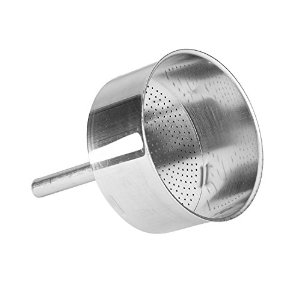
|
|
|
RogueRose
International Hazard
    
Posts: 1585
Registered: 16-6-2014
Member Is Offline
|
|
Quote: Originally posted by j_sum1  | Circular cotton make-up removal pads might be worth a shot.
Actually they would probably match well with a piece of a stovetop espresso maker I have for a buchner funnel.
|
The square swabs that I wrote of are pretty similar to the round pads you speak of - if I hadn't explained them correctly. The round pads seem to be
a little different texture.
|
|
|
The Volatile Chemist
International Hazard
    
Posts: 1981
Registered: 22-3-2014
Location: 'Stil' in the lab...
Member Is Offline
Mood: Copious
|
|
I recently used the below idea to use a vacuum flask for which I had no stopper/seal. The red bulb is the bulb for a large glass pipette which had
broken.
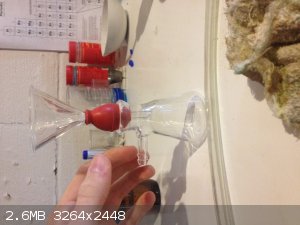
|
|
|
mayko
International Hazard
    
Posts: 1218
Registered: 17-1-2013
Location: Carrboro, NC
Member Is Offline
Mood: anomalous (Euclid class)
|
|
An aquarium air pump can be useful for pseudo-vacuum filtration. If I am filtering a slow-moving mixture, though a bit of cotton in a pipette for
example, the gently pressurized air can speed things up a great deal. (I am told they can also be used for flash chromatography)
al-khemie is not a terrorist organization
"Chemicals, chemicals... I need chemicals!" - George Hayduke
"Wubbalubba dub-dub!" - Rick Sanchez
|
|
|
CharlieA
National Hazard
   
Posts: 645
Registered: 11-8-2015
Location: Missouri, USA
Member Is Offline
Mood: No Mood
|
|
Excellent!!!
|
|
|
JJay
International Hazard
    
Posts: 3440
Registered: 15-10-2015
Member Is Offline
|
|
Repurposed.
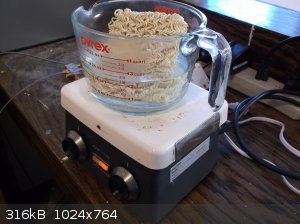
|
|
|
RogueRose
International Hazard
    
Posts: 1585
Registered: 16-6-2014
Member Is Offline
|
|
Air bubbler or tiny compressor to help filtration
I've read that some people use air bubblers to help with their gravity filtration. I'm kind of confused as to how they use these for that purpose.
Do they use a vacuum flask with the vacuum port connected to the input of the bubbler or do they use a sealed holding container (for the liquid to be
filtered) and pump air into the sealed container (positive pressure filtration)?
I'm considering a positive pressure setup as it can be made with what I have at hand plus a bubbler or small compressor.
I currently use gravity filtration with the assist of a long 10ft length of 3/8" tubing. The hose connects to a barb through the lid of an old gallon
juice jug lid & the jug has a hole cut in the bottom to allow for filling as well as rope through the side (sealed for liquid) to hang the
container. A filter is placed above the receiving container and connected to the hose. The juice jug is filled and raised as high as possible to
allow for greater pressure.
The above method works pretty well but there are times it could be faster. To do this I picture a second barb on the lid to allow for air to be
pumped in. A sealed jug would be used for the positive pressure obviously.
I was considering one of those 12vdc auto air compressors with a modified hose fitting. I suspect it will pump air too quickly and I don't need
100psi (can the pressure be set on these?) so I was thinking of running the motor with something like 3.3 or 5v (from a computer PSU) which I suspect
will make the motor run much more slowly but IDK if it will just draw more current.
If a bubbler is used, does it have to be submerged in anything or can it hang outside the jug and just pump the air into the jug?
|
|
|
symboom
International Hazard
    
Posts: 1143
Registered: 11-11-2010
Location: Wrongplanet
Member Is Offline
Mood: Doing science while it is still legal since 2010
|
|
This a great thread often its cheaper to improvise many time for reasons such as cost or availability being a DIY kind of person. This thread is very
helpful and interesting what others come up with
Definitely deserved to be topped
[Edited on 16-5-2016 by symboom]
|
|
|
CharlieA
National Hazard
   
Posts: 645
Registered: 11-8-2015
Location: Missouri, USA
Member Is Offline
Mood: No Mood
|
|
drying rack
My wife found this baby bottle drying rack at a rummage sale for $1. Now it's a lab glass drying rack (some might say it is MY baby bottle drying
rack.
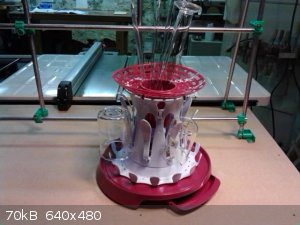
|
|
|
RogueRose
International Hazard
    
Posts: 1585
Registered: 16-6-2014
Member Is Offline
|
|
Home made pestle
I needed something to crush large crystals and charcoal and things such as this. So I came up with this:
 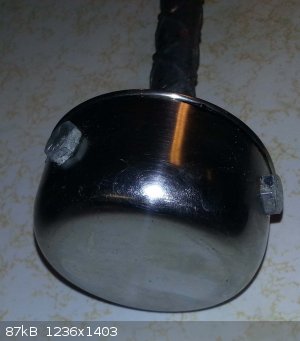 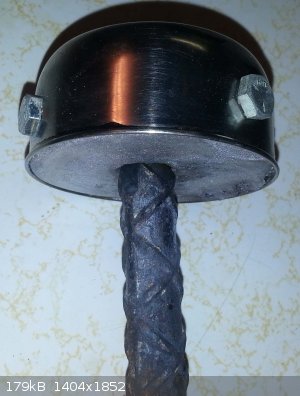
IDK how thick the rebar is but the measuring cup is 3/4 cup and filled with lead. I added screws & nuts on the inside to lock everything in
place. I would guess this all weighs close to 5-6 lbs and works great for breaking up whatever is needed
|
|
|
Firmware21
Harmless

Posts: 33
Registered: 22-1-2015
Member Is Offline
Mood: Ņ͈̣̭̺̈ͬ͊̔i̓̿͑ͯ̂ͪ҉̸̺̀t͉̣͕͙̟̪̅͐͂̏͌ͭ͗̑͝ṙ̶̛̙̥̝̻̟̓ͬ̾ͧ͒͘ͅa͒͊ͯ̾̑̏̌̓̕҉͚͚͓͔͙͚̥t͆̌͑ͩ̐͗
͖̻̲̪̲̙͘ͅe͙͕͙̙̤̤̫̒ͩͣ̅̊̍̉͒ͬ́͟ͅs͈̬̮̥̻͂ͥͨ̂ͮͨ͒́͠ !!!
|
|
Homemade magnetic stirrer with a 4 positions speed selector. It's working pretty well, although the stirbar has a bad habit of "not staying where it
should" when the solution is difficult to stir (Thick precipitates, cellulose in schweizer reagent).
I had almost everything except the magnets (Very strong neodymium magnets) and the selector. It was quite of a hassle to center them to get the
desired effect 
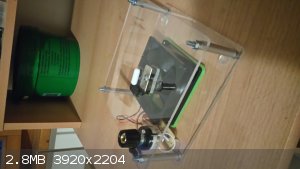
I tried to use a potentiometer but they all burned.
[Edited on 17-5-2016 by Firmware21]
|
|
|
The Volatile Chemist
International Hazard
    
Posts: 1981
Registered: 22-3-2014
Location: 'Stil' in the lab...
Member Is Offline
Mood: Copious
|
|
Does anyone have a source for a home-made iron-piping style DIY Bunsen burner like what Doug's lab has? I really like the design, but he's never
posted here or on YouTube with regards to how it was made.
|
|
|
CharlieA
National Hazard
   
Posts: 645
Registered: 11-8-2015
Location: Missouri, USA
Member Is Offline
Mood: No Mood
|
|
re Rogue Rose's pestle
Great idea! Now I have another use for my 6-lb sledge. I tried to crush some sea shells with a regular mortar and pestle, but I won't live long enough
to crush a significant amount. Now where did I put that sledge...
|
|
|
CharlieA
National Hazard
   
Posts: 645
Registered: 11-8-2015
Location: Missouri, USA
Member Is Offline
Mood: No Mood
|
|
Safety shield
I just finished making a safety shield from a piece of 0.1 inch thick, 18 "x24" poly-carbonate. The blue strips are masking tape so you can tell where
the plastic is. I'm already thinking of making another one so I can put 2 side by side, either horizontally or vertically (or even 1 each way, I
suppose).
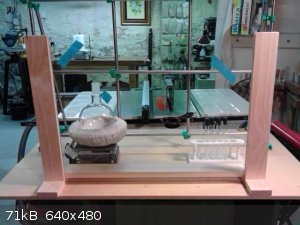 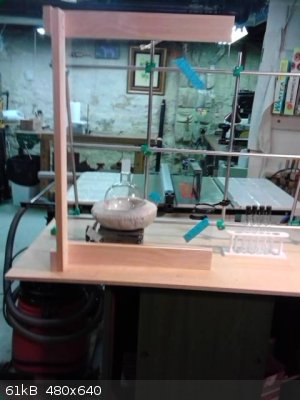
|
|
|
aga
Forum Drunkard
    
Posts: 7030
Registered: 25-3-2014
Member Is Offline
|
|
Cor ! You can hardly see it's there.
I wish i could get my Glass that clean !
|
|
|
Sulaiman
International Hazard
    
Posts: 3554
Registered: 8-2-2015
Location: 3rd rock from the sun
Member Is Offline
|
|
Firmware21
very nice,
but unless you are a lot more careful than me,
liquids will get to the potentiometer.
A small piece of acrylic glued diagonally across the corner where the pot is would help,
I'd consider as large diameter as fits ring around the top to form a shallow well,
or glue flat strips of acrylic into a square well.
It will not look as pretty,
but spilled liquids and electronics is not usually a good combination 
I just had a thought, (it happens occasionally)
you could add some baffles to direct the air from the fan around the front top edge,
this would gently encourage nasty fumes (HCl etc.) to move away from you instead of biting your nose.
Another thought ...
a ceramic tile (the type used on walls) placed in the middle,
a stand, clamp & something like this http://www.ebay.co.uk/itm/TRAVEL-HEATER-ELEMENT-WATER-COFFEE...
would allow heating with stirring ... very useful.
|
|
|
CharlieA
National Hazard
   
Posts: 645
Registered: 11-8-2015
Location: Missouri, USA
Member Is Offline
Mood: No Mood
|
|
There isn't a window in my house as clear and clean as this sheet of plastic!  
|
|
|
Texium
|
Threads Merged
20-5-2016 at 05:51 |
Firmware21
Harmless

Posts: 33
Registered: 22-1-2015
Member Is Offline
Mood: Ņ͈̣̭̺̈ͬ͊̔i̓̿͑ͯ̂ͪ҉̸̺̀t͉̣͕͙̟̪̅͐͂̏͌ͭ͗̑͝ṙ̶̛̙̥̝̻̟̓ͬ̾ͧ͒͘ͅa͒͊ͯ̾̑̏̌̓̕҉͚͚͓͔͙͚̥t͆̌͑ͩ̐͗
͖̻̲̪̲̙͘ͅe͙͕͙̙̤̤̫̒ͩͣ̅̊̍̉͒ͬ́͟ͅs͈̬̮̥̻͂ͥͨ̂ͮͨ͒́͠ !!!
|
|
I thought about the potentiometer problem, i think I'll just use some kind of plastic container instead of modifying the stirrer. I'm more concerned
about me getting fried by the stirrer than just breaking it. I therefore avoid manipulating liquids when it's plugged in and cover the beaker with
something.
For the heat insulation, a tile seems to be a better alternative to the old corkboard I planned to use.
Concerning the heating element, corrosives/redox will mess with it quickly and break it.
|
|
|
Orenousername
Hazard to Self
 
Posts: 79
Registered: 16-4-2016
Location: USA
Member Is Offline
Mood: Regulated
|
|
Quote: Originally posted by The Volatile Chemist  | | Does anyone have a source for a home-made iron-piping style DIY Bunsen burner like what Doug's lab has? I really like the design, but he's never
posted here or on YouTube with regards to how it was made. |
Doug actually posted about the design of his burner in:
http://www.sciencemadness.org/talk/viewthread.php?tid=36062 
Lol nerds
|
|
|
BobD1001
Hazard to Others
  
Posts: 182
Registered: 29-3-2013
Member Is Offline
Mood: No Mood
|
|
Quote: Originally posted by battoussai114  | I have a cheap magnetic stirrer too. Mine uses a 12v power supply from my old home phone, a 12v PC fan and 2 savaged neodymium magnets.
I'm currently working on a hotplate. Got a stainless steel plate from a local metal shop, some nichrome wire and a potentiometer. The only problem is
that my only available power supply output a max 6W. I'm not sure if I'll bother trying to add temperature control (even though I have some spare MCUs
laying around), probably I'll just estimate the temperature based on the voltage drop across different positions of the potentiometer wiper.
|
If your building a homemade hotplate/stirrer check out the one I built here. Used a cheap PID controller from aliexpress and some heating cartridges
from ebay (two 400W, totaling 800W). The PID control is excellent and it heats up very fast. https://www.youtube.com/watch?v=t6mOZeyTi84
|
|
|
Harristotle
Hazard to Others
  
Posts: 138
Registered: 30-10-2011
Location: Tinkerville
Member Is Offline
Mood: I tink therefore I am
|
|
Magnetic Stirrer
Well, I used a great design and laser cut it at my local maker space.
The little pwm speed controller is excellent, and so I have included its build designs.
I bought the acryllic by paying a sign maker a $2 gold coin donation to go dumpster diving - got enough for 30.
You can see it here https://www.youtube.com/watch?v=W7rLZ33ps2I
. In reality, it works better than discribed, as the epoxy the magnets rubbed against is drier and rubbed down now - I didn't let it set properly
before I tried it out.
The laser cutter files are here: https://github.com/BioHackAcademy/BHA_Stirrer - The biohack academy is well worth a look.
I have attached a schematic, and the reference I thieved it from -in Eagle format, a pdf of my pcb layout, and a component overlay file.
It was a very useful device, and I recommend it.
Sorry that my Eagling is not pretty, but it does the job.
Cheers,
H.
Attachment: motor controller.sch (203kB)
This file has been downloaded 785 times
Attachment: motor controller -components.pdf (11kB)
This file has been downloaded 532 times
Attachment: motor controller.pdf (9kB)
This file has been downloaded 530 times
|
|
|
ficolas
Hazard to Others
  
Posts: 146
Registered: 14-5-2016
Member Is Offline
Mood: No Mood
|
|
Quote: Originally posted by Firmware21  | I thought about the potentiometer problem, i think I'll just use some kind of plastic container instead of modifying the stirrer. I'm more concerned
about me getting fried by the stirrer than just breaking it. I therefore avoid manipulating liquids when it's plugged in and cover the beaker with
something.
For the heat insulation, a tile seems to be a better alternative to the old corkboard I planned to use.
Concerning the heating element, corrosives/redox will mess with it quickly and break it.
|
You need to use a voltage regulator, or your potentiometers will eventually fry.
A 12V (300mA maybe?) DC Power source wont really cause much harm, it may shock you if you touch both ends with wet hands, but nothing really bad
should happen (Acording to my knowledge, and a electrical engineer friend I asked because I was scared of using things wired to the wall, even if
working with low current and low voltage)
I'll be using an waterproof project box (Something like this: https://www.amazon.com/Estone-Waterproof-Plastic-Electronic-... ) And cover all the holes I make in the box for the pot, etc as good as I can.
Here is the schematic i'll follow, where they also use a voltage regulator so that pots dont fry over time.
|
|
|
Firmware21
Harmless

Posts: 33
Registered: 22-1-2015
Member Is Offline
Mood: Ņ͈̣̭̺̈ͬ͊̔i̓̿͑ͯ̂ͪ҉̸̺̀t͉̣͕͙̟̪̅͐͂̏͌ͭ͗̑͝ṙ̶̛̙̥̝̻̟̓ͬ̾ͧ͒͘ͅa͒͊ͯ̾̑̏̌̓̕҉͚͚͓͔͙͚̥t͆̌͑ͩ̐͗
͖̻̲̪̲̙͘ͅe͙͕͙̙̤̤̫̒ͩͣ̅̊̍̉͒ͬ́͟ͅs͈̬̮̥̻͂ͥͨ̂ͮͨ͒́͠ !!!
|
|
Quote: Originally posted by ficolas  |
You need to use a voltage regulator, or your potentiometers will eventually fry.
A 12V (300mA maybe?) DC Power source wont really cause much harm, it may shock you if you touch both ends with wet hands, but nothing really bad
should happen (Acording to my knowledge, and a electrical engineer friend I asked because I was scared of using things wired to the wall, even if
working with low current and low voltage)
I'll be using an waterproof project box (Something like this: https://www.amazon.com/Estone-Waterproof-Plastic-Electronic-... ) And cover all the holes I make in the box for the pot, etc as good as I can.
Here is the schematic i'll follow, where they also use a voltage regulator so that pots dont fry over time. |
I already use a 12 V adapter, it would have fried otherwise. I was just scared about getting shocked 
And actually, it's not a potentiometer but a 4 position interuptor. I regulate the speed using a couple of resistors. I tried to use potentiometers,
but they burned...
|
|
|
| Pages:
1
..
7
8
9
10
11
..
18 |